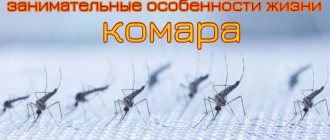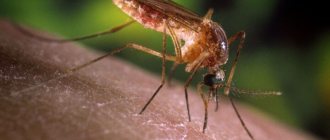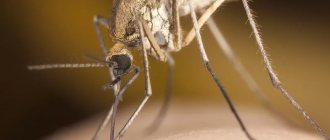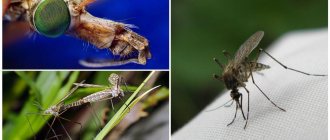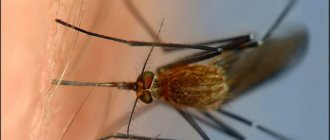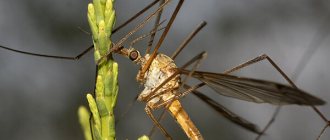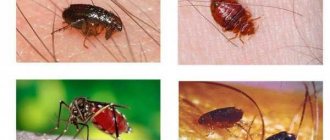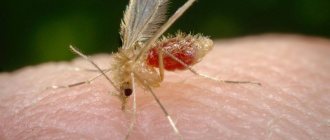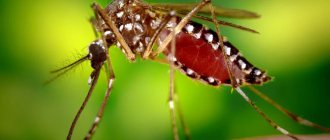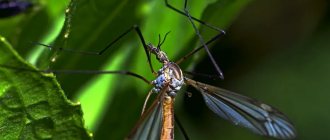Mosquitoes are small two-winged insects distributed throughout the world. In nature there are 3 thousand of them, and in Russia there are 100 species. All are characterized by a piercing-sucking structure of the oral apparatus and complete transformation. The squeak mosquito is the most common species in the temperate zone. The female needs blood feeding to lay eggs. It bites humans and warm-blooded animals. Mosquitoes are carriers of dangerous infections and parasites. The introduction of saliva into the wound leads to the development of allergies and eczema.
Who are mosquitoes?
Mosquitoes are a family of dipterous insects that belong to the long-whiskered group. Mosquitoes have a rather complex classification. The family is divided into 2 subfamilies, one of which, in turn, is divided into tribes, then into genera and species.
Appearance of a mosquito Interesting fact: among insects, only females bite, since males have underdeveloped jaws. Female mosquitoes are part of the midges - a group of dipterous blood-sucking insects, which also includes midges, mosquitoes and other families.
Description and classification
The mosquito larva is called a bloodworm. Their color may vary depending on the species they belong to. In particular:
- The squeak mosquito has brown or black larvae.
- Malaria mosquitoes usually have green-colored babies.
- The bell is characterized by a red color.
At the time of birth, the size of the larvae usually does not exceed 2 millimeters; over time they can increase to 1 centimeter. They have 2 eyes, and on the ring of the body there is a special tube through which the process of their breathing is carried out. In addition, bristles are located throughout the body of the individual, thanks to which it can move in the water; they are called swimming hairs.
Features of the oral apparatus
The oral apparatus, which allows the mosquito to feed, is distinguished by its piercing-sucking type. It is characterized by a rather complex structure, is located in the lower part of the mouth, and has the shape of a proboscis tube. The sharp stylets of the jaw are also located here.
It is important to understand that a mosquito can be a carrier of dangerous infections - malaria, yellow fever, West Nile fever, tularemia.
A human bite occurs as follows: lowering the proboscis inside the skin to the depth where the capillaries are located. Having cut a hole, the insect can easily suck out the blood.
Types of mosquitoes
There are more than three thousand species of mosquitoes. In the article we will consider the most common varieties that people most often encounter. Not all of the known and widespread mosquitoes in our area drink blood. Let's find out which mosquitoes can cause harm to humans, and which are completely harmless.
Common mosquito (squeaker)
An adult squeak mosquito reaches 7 mm, the legs are long, the wings are narrow and transparent, the body color is gray. They belong to the species Culex. Females are superior to males in body size and antennae length. In males, the proboscis is not so developed as to pierce the skin of a mammal, so the basis of their diet is plant foods. Only females bite and drink lymph. The life cycle of a mosquito does not exceed 48 days. The habitat and reproduction are places with high levels of humidity. This species is especially common in the central zone of our country.
Malaria mosquito (Anopheles)
Anopheles (malarial mosquito) is especially dangerous for humans, as it carries parasites and viruses that cause severe pathologies: plasmodium and malaria. In size they practically do not differ from ordinary representatives of this family. The only peculiarity: long hind legs. The habitat of this mosquito is places near bodies of water, since reproduction is possible only in the presence of an aquatic environment.
Centipede mosquito (Karamor)
The centipede mosquito can reach a length of 8 cm, so it is often confused with the malaria mosquito. Karamor is the largest species in the world. It lives in places with high levels of humidity: near water bodies, in forest thickets and in swamps. This type of mosquito is not dangerous for humans, since the insect’s diet consists exclusively of plant foods. However, this species can cause significant damage to agricultural crops. This is especially true for larvae, which are extremely gluttonous.
Winter mosquitoes (Chionea)
In addition to the Karamora, winter mosquitoes differ from the above species by their impressive size. The basis of their diet is products of decomposing plants. They do not pose a danger to humans, since they are not among the blood-sucking insects. Adults can reach sizes up to 2 cm. They do not disappear all year round, so they can be seen even in the cold season.
Tiger mosquitoes
It is distinguished by the presence of white stripes on the body and legs, larger size and darker color. Habitat: subtropics and tropics. They are aggressive. They are carriers of dangerous infectious diseases, for example, dengue or yellow fever, and therefore pose a danger to humans. The basis of the diet of mosquitoes of this species is the blood of mammals. The bites are very painful.
Stinging mosquitoes
An adult stinging mosquito reaches 12 mm. The habitat of insects of this species is forest thickets. The color of the insects is beige-yellow, there are dark spots on the wings, and white rings on the legs. Females differ from males in having a long proboscis and shaggy antennae. Stinging mosquitoes pose a danger to humans, as they spread a serious disease - tularemia.
Mosquito Dergun
The habitat of these insects is dense vegetation on the shores of small bodies of water. The lifespan of mosquitoes of this species is no more than 5 days. For humans, the jerk mosquito does not pose a danger, since it feeds exclusively on plant foods. The adult is dark brown in color with relatively long legs.
Habitat and lifestyle
Every person has had to wake up from the bite or annoying squeak of mosquitoes. This suggests a conclusion about their predominant way of life. Insects prefer to get food at night, and during the day they hide in dark shelters - among the grass, in cracks in the bark of trees.
The closer the river, swamp, lake, the greater the likelihood of encountering countless hordes of squeakers. This is due to their life cycle, part of which takes place in the aquatic environment. Parasites are ubiquitous. You will not find them except in the Arctic or desert, where they cannot reproduce.
During the winter, the parasite prefers to hide in the basements of residential buildings. The presence of small puddles and warmth allows them to “spend time productively.” The pupae develop into an adult, which flies into people's homes in search of food.
Physiological needs
Insects accumulate their main reserves of energy at the larval stage; being an imago, they can freely be content with flower nectar. Glycogen is released from its carbohydrates, which is actively consumed during the flight. A male mosquito lives about 20 days.
In addition to carbohydrates, the female requires protein, lipids, and iron. It receives these components from the blood. With such a diet, it can live on average 40 days, in some cases it lives up to 60. If eggs are laid without replenishing protein reserves, the body weakens, and the insect dies after 20 days. At one time, the female is able to eat about 5.2 ml of blood, her weight is 3 g.
Appearance of larvae and what they are
Gadflies lay eggs under human skin, where the larvae develop. In appearance they resemble the shape of a pear. There are rows of spines across their body, and a sclerotic capsule is located below. The length of the larvae can reach 25 cm, in diameter - 7 mm. With the help of hangnails, the parasite attaches itself to the tissues of the body, feeding on blood, accumulating substances useful to itself. The fluid secreted by it causes severe pain, causing a disease in a person - cutaneous myiasis.
After birth, the gadfly larva is quite small. However, under the skin of a mammal it grows very quickly and after a couple of weeks can reach a length of 20 mm.
Externally, the larva looks like a maggot. Only its body is pear-shaped with several transverse rows of spikes resembling hooks. She uses them to securely attach to the skin, hair or fur. The main food is blood.
The development cycle of a gadfly larva does not exceed 5 weeks on average. But having become an adult, it continues to parasitize the host for another 2-3 months, absorbing nutrients and receiving oxygen through a fistula formed in the epidermis. After which it tries to get out from under the skin to pupate.
Life cycle
The gadfly is an insect that has a closed chain of transformations. The complete development cycle involves the path from the larva to the adult stage. The insect lives from 3 to 20 days. By the end of life, it loses approximately 1/3 of its own body weight. Under unfavorable climatic conditions, it seems to freeze, living on plants. Any life cycles within the insect's body will be slowed down.
The gadfly larva will go through 3 stages of formation inside the human body. At all stages it has a characteristic shape:
- At stage 1, it looks like a small headless and legless white worm. At the end of the body there is a thickening with 3 black stripes. This stage of formation lasts 7 days, after which it molts and moves on to the next one.
- At stage 2, the larva is large in size and bottle-shaped. After 18 days, the insect molts and moves to the next stage.
- At stage 3, the gadfly will increase in size. After about a month, it will become an adult and will continue to stay in the host’s body for up to 10 weeks, then it will crawl to the surface of the skin and leave the person, falling to the ground.
Each stage is characterized by small black dots and spikes surrounding the thorax.
External differences between female and male mosquitoes
The usual mosquito family consists of male representatives. Initially, the lifestyle of insects is no different. Subsequently, the female mosquito drinks blood as it expends more energy. Males continue to be content with little, often gathering on the flowers of thistle and elderberry. Who bites - a male or a female, you can definitely answer “she”.
Female and male mosquito
The gender of mosquitoes can be distinguished by their appearance if you look closely. Mosquitoes are always larger, body size is about 7 mm, males grow to a maximum of 5 mm. There are differences in the structure of the oral apparatus. Both sexes have a proboscis, but females have an additional row of teeth with which they pierce the skin and prevent the wound from closing.
The main difference is in the shape of the mustache. The mosquito with the furry antennae is a male. Outwardly, they resemble a brush and are clearly visible on a small head. In mosquitoes they are long, in the form of branches. What a male mosquito looks like is shown in the photo below. There you can also see what a female mosquito looks like.
On a note!
There are about 100 species of mosquitoes in our area. The most common is normal. Lives in wild nature and urban areas. The largest swamp mosquito in size. Urban ones are weak, not so active, females grow up to a maximum of 5 mm, males up to 3. Another striking representative is the centipede. Externally it is distinguished by its large dimensions - up to 60 mm. It feeds on nectar, lives in the wild, does not need protein reserves or blood.
Lifestyle
The habitats of the squeak mosquito are coastal areas of water bodies, forests, forest-steppes, and urban areas. Adults settle near water, in basements and attics. In hot tropical regions, mosquitoes are active all year round. In areas with a temperate climate, insects enter diapause during the cold period. Only the female overwinters. Having settled in heated basements, mosquitoes can become active and...
Males and females feed on plant nectar and various syrups. They are often spotted on sugar and sweet foods. Insects have weak wings and cannot fly in windy weather. In temperate climates, mosquitoes are active from May to October, but appear earlier in warm weather. How long a squeak mosquito lives depends on several factors:
- amount of food;
- climatic conditions;
- natural enemies.
Favorable conditions (low temperature, sufficient food) can prolong the life of the female, and the male's life is limited to 18-19 days. Females of the summer generation live 1-2 months, females of the spring generation – up to 4 months. Moderate temperatures promote longevity:
- 25° - 42-43 days;
- 20° - 55-58 days;
- 10-15° - up to 120 days.
Negative conditions for the existence of dipteran insects are drought, temperatures below 8°, at which they lose activity and stop feeding. In autumn, the last copulation of insects occurs. The males die, and the females search for winter shelter. They hide in cracks, under the bark, deep into the litter. City mosquitoes get into people's homes. If they find a suitable damp basement or container of water in a heated building, the reproduction cycle will not be interrupted for the winter.
Reproduction
Young adults drink plant juice after emerging from the pupa. Females do without blood until it is time to reproduce and lay eggs. In the evening, in warm weather, you may notice mosquitoes swarming. It is observed near bodies of water, in meadows, near the crowns of trees or bushes, on paths. A cluster of insects moving in a vertical position facilitates the meeting of different-sex individuals. Males identify partners by sound and mate.
After fertilization, the female looks for a victim; she can drink blood from a bird, animal, or person. Blood serves as a source of beneficial nutrients necessary for the development of strong offspring. In search of a power source, she travels 5-12 km. The next step is to find a place suitable for laying. This could be a body of standing water or a container.
The female lays from 20 to 200 oblong eggs, glued together in the form of a boat or raft. They do not drown and float freely on the surface of the reservoir. At first the masonry is white, then it darkens. Buoyancy is provided by the special shape of the egg. One end of it is wide and blunt. Laying is done every 2-3 days. In warm weather (23-25°), the embryo develops in 3-5 days. The larvae stay near the surface. In the first days of life, they are especially vulnerable and become victims of numerous aquatic predators.
Most of the larval stage is spent upside down. In this position, it hovers near the surface, filtering water with its oral appendages and swallowing algae, ciliates and rotifers. Having emerged from the egg, the larva has a body length of 1-2 mm; before pupation it reaches 6-7 mm. She goes through 3 molts and 4 instars. Pupation occurs at one week of age. The pupa is mobile, shaped like a comma. The abdomen is narrow, the head and thorax are fused. After 2-10 days, an adult mosquito emerges from the pupa.
Nutrition of sugars in vegetation
Small and large mosquitoes can feed on nectar or food of plant origin, since they contain substances necessary for replenishment.
Among the preferred plants are:
- Burdocks;
- Blooming tansy;
- Yarrow latifolia.
What mosquitoes choose to eat depends on their habitat. For example, forest dwellers and inhabitants of summer cottages choose tansy - at the same time one flower can accumulate up to 10 individuals. Tansy contains fructose, which has a beneficial effect on the health of this type of pest.
History of discovery
People have always known about mosquitoes, but this species was first scientifically described by Carl Linnaeus in 1758. Later in 1775, Forscal described the same species in Egypt under the name Culex molestus. They both bear close physical resemblance to each other, and scientists later agreed to distinguish these mosquitoes by their willingness to bite people. Culex molestus was more abundant in Alexandria, Rashid and Cairo. Ficalbi
) in 1890 proposed to call the squeaking mosquitoes that bite people “haematophagus”, and those that do not bite people, but feed only on nectar, to be called “phytophages”
Thus, in relation to Culex molestus, partial attention was paid to the degree of biting people; later their behavior was designated by the term “anthropophiles”
The siphon is located on the eighth segment of the abdomen and serves for breathing air. At the end of the siphon there are valves that close when the larva is immersed deep in the water. The larva moves thanks to the caudal fin on the last, ninth segment of the abdomen, consisting of setae.
Mosquito feeding
The basis of nutrition is sugars of plant origin. Rarer types of food for mosquitoes are exofloral nectar and honeydew. Female mosquitoes combine plant food and blood, while male mosquitoes feast only on flower nectar and plant juices.
Feeding of females
The “thirst for blood” in females is explained by the fact that they need animal protein to produce eggs after mating. For this reason, they attack humans and mammals, and some species bite birds and reptiles.
While biting the skin, saliva is simultaneously introduced into the microscopic hole, which contains anticoagulants - they prevent blood clotting and, consequently, its thickening. Therefore, liquid blood is easily absorbed by the female mosquito through her long proboscis. The preferred hunting time for mosquitoes is the evening and night hours, when there are no scorching rays of the sun.
Saliva contains substances that cause an allergic reaction in humans. For this reason, the bite site sometimes becomes swollen and red, and severe itching appears in the affected area. The use of antihistamines will help relieve unpleasant symptoms.
How do they choose their victims?
Despite their small size, mosquitoes have excellently developed sense organs. All over the surface of the body there are receptors that can recognize the presence of a person at a distance of 40–50 m. The characteristics of the odor that the insect detects are the fundamental criterion in choosing a victim and a sign of the start of an attack.
Most of the mosquito's olfactory receptors are tuned to recognize substances present in the blood and sweat of a person or animal. The species Anopheles gambiae, which carries the most dangerous malaria, almost always chooses only humans as a source of food, although observations carried out by scientists have shown that in the absence of an available alternative, the female will ultimately attack any victim because she is in dire need of protein food.
When searching for a source of blood, the female is guided by:
- The amount of carbon dioxide. This compound attracts insects because it is produced by humans and animals when they breathe. Along with it, a person exhales a whole list of other chemicals: octenol and various acids. Mosquitoes, thanks to their sensitive receptors, painstakingly distinguish this composition and analyze it, choosing the most preferable victim. So, in an adult, a larger volume of substances comes out of the respiratory tract, so they are bitten more often than small children. The “preference list” of bloodsuckers also includes pregnant victims, whose ratio of exhaled substances changes when expecting a child.
- Body odor. It depends on colonies of bacteria living near the gonads. Sweat, as a biological fluid, has an unpleasant odor for humans, but is very attractive to mosquitoes. Therefore, a person who has been doing hard work for a long time will be attacked faster than someone who has just left and soul.
- Skin discharge. Mosquitoes are good at capturing the substances contained in them and rush to their prey.
- Blood type. According to the results of the studies, mosquitoes “like” the first group, and they attack people from the second group the least often.
- Lactic acid. It is released along with sweat and exhaled carbon dioxide.
There are other parameters by which bloodsuckers choose a victim. These include the temperature of a person’s body, the movements he makes, and even the color of his clothes. But it is the aroma of a person and the composition of the biological fluids he secretes that play a key role.
Male nutrition
What male mosquitoes eat makes them completely harmless, because all their lives they look for food of plant origin. Substances necessary for their short life accumulate in their body during the time they are in the larval stage. Therefore, their oral apparatus lacks cutting elements as unnecessary.
Lifespan
The lifespan of a mosquito can be from 1 month to a year. This indicator is influenced by various factors and living conditions. Insects spend the winter period in a state of torpor. Mosquitoes love to live near bodies of water with standing water. Here they feel comfortable.
To understand exactly how long an ordinary mosquito can live, it is worth considering the conditions that can affect the lifespan of creatures:
- availability of a food source. Males eat plant foods and also feed on nectar from plants. Only females drink blood. They are the ones who can attack people, animals, fish, and amphibians.
- Ambient temperature indicators. The comfortable range for creatures is considered to be from +100C. The female can live calmly at this temperature for about three months. And if it rises to +200C, then individuals can live for two months. The lifespan of mosquitoes lasts no more than 40 days if the mark on the thermometer exceeds +250C. Under the same conditions, males live half as long.
- Availability of a comfortable living environment. This factor refers to the presence of an optimal humidity indicator. For this reason, creatures prefer to live in cold utility rooms, basements, cellars;
- The presence of nearby enemies - birds, animals, humans.
Mosquitoes are more dangerous than you think
How many days does a mosquito live after being bitten?
Many people believe that after a mosquito bites, they die immediately, but this is not so. Adults can eat up to 8 times in a few hours, and the insects will feel great. For this reason, when 3-4 mosquitoes fly in, it seems as if a whole swarm of buzzing bloodsuckers has arrived.
There is no connection between a mosquito's bite and lifespan.
The only thing that can happen when bitten is death from a person. At the moment when the insect bites, poison is injected, which causes severe pain, and many swat the parasite at the scene of the crime, thereby shortening the mosquito's lifespan.
What do mosquitoes eat in the forest?
Many people are interested in what ordinary mosquitoes eat in the forest. After all, people rarely go out into nature. To obtain the necessary components, insects attack animals and birds. Pests do not notice obstacles on the way to food. They are not stopped by fur or hard feathers. It takes them 2–5 seconds to overcome this obstacle. Mosquitoes show dexterity in places where there is no food.
Pests easily penetrate through the skin or fur. Although their proboscis is small, they receive the required amount of blood. After all, they suck out lymph at a tremendous speed.
Maximum mosquito activity occurs in the pre-dawn hours and at sunset. Receptors and olfactory organs are used to search for prey. Some types of parasites are able to select a potential victim at a distance of 10 meters.
What do mosquitoes eat in the swamp?
It is known that females drink predominantly lymph. In swamps, they select food sources such as frogs, birds or fish.
Not many people know what a mosquito in a swamp feeds on, other than blood. Thus, the centipede prefers to eat humus or algae. Adult mosquitoes absorb plant juices or nectar.
Here's what different types of mosquitoes eat in the swamp:
- Bolotnitsa. The meadow feeds on plant nectar and the remains of rotting algae.
- Zvonets. The jerk mosquito also eats vegetation. The insect lives in the reeds. The color of the pest is green-yellow or dark brown.
- Karamora. The centipede does not drink blood, but feeds on plant sap or nectar. Caramora larvae have the greatest appetite; they eat algae, roots, and young vegetation in water and on land.
Mosquito breeding
During the mating period, the female mosquito uses its wings to produce a characteristic thin squeak. The resulting sound vibrations are caught by males through sensitive antennae. Depending on the age of the individual, the sound of the squeak also changes. It is noteworthy that males are able to distinguish these sounds and show preference for more mature females.
Mating takes place in a swarm formed by mosquitoes. The life cycle of a mosquito consists of four stages:
- egg;
- larva;
- chrysalis;
- imago (adult).
Interesting: Enemies of bees - list, description, photos and videos Life cycle of a mosquito
On average, the number of eggs in a female’s clutch is 30-150 (every 2-3 days). Sometimes this number increases to 280. The reproduction process depends on whether the females have consumed enough blood.
Suitable conditions for laying eggs: the surface of standing water (or weakly flowing), soil on the shore, objects floating in the water. Requires high levels of moisture. If the eggs float on water, they form a kind of raft.
The larvae emerge over the next 48 hours from the lower end of the egg. Some types of mosquitoes lay eggs throughout the winter. On the fourth molt, a pupa emerges from the larva. The process of larval development and duration depend on the ambient temperature. As a rule, individuals become adults after a week or two. Sometimes this takes longer - about a month.
Body structure
The mosquito's body is divided into several parts. The head is attached to the thoracic region using three shield plates. It has sensitive antennae, huge compound eyes and mouthparts. In the middle part of the body is the chest, divided into three segments. The legs, abdomen and wings of the insect are attached to it. There is also a spiracle connected to the trachea.
Why do we hear the characteristic mosquito squeak? It is produced by paired wings, equipped with edges along the edges. The high vibration frequency is detected by the human ear in the form of a ringing sound. The parasite makes 500-1000 swings per second. The wings consist of various veins covered with a small number of scales.
How many limbs does a squeaking mosquito have? To answer this question, you need to carefully examine the adult. Six thin legs are attached to its thoracic region. They have a rather complex structure, allowing the insect not only to stay on the skin of the victim, but also to crawl on its bellies. Each foot has five segments with suction cups at the end, the last of which is equipped with two claws.
Drinking blood
Only females have a need for protein contained in the blood of humans and animals. To find a potential source, pests monitor the heat emitted by people's bodies or the aroma of carbon dioxide that is released when people exhale. In parks and in nature, the insect feeds on the lymph of an animal or livestock.
According to studies, scientists have determined whether mosquitoes will attack birds. Yes, they can consume the lymph of certain species of birds, and the food chain of bloodsuckers also includes rodents. Also, laboratory conditions made it possible to find out how much blood the pests drink at one time. For example, an insect weighing 3 milligrams drinks about four to five milligrams of blood.
To be able to provide constant nutrition to a female, certain conditions must be present. For example, egg laying should be carried out in an area where there is a high level of humidity and an acceptable temperature. Because of this, females choose places near ponds, swamps or containers where water has stagnated. If we talk about urban conditions, then the choice falls on basements.
Life cycle
The lower part of the eggs is equipped with a special “hatch”. After 2-8 days, larvae emerge from the clutch. They need to gain strength and grow up. To do this, the newborn bloodworm feeds on protozoa, single-celled algae and bacteria. The body length of the larvae is only 1 mm. In the tail part there is a breathing tube with which they pierce the surface of the water and absorb atmospheric air. How many legs does the squeak mosquito have in its larval stage? Yes, they simply don’t exist! The slightest threat - and, wriggling its whole body, the bloodworm will hide in the water column.
In three weeks, the larva goes through 4 stages of molting. Their body increases in size to 8-10 mm, lengthening 8 times. After such metamorphoses, which are also accompanied by internal changes, pupae appear. They are sometimes called “devils” due to the presence of two respiratory processes in the head. Externally, the bloodworm looks like a tightly coiled worm, reminiscent of a comma.
The next stage of development ends in a week. Having shed the skin of the pupa, the mosquito spreads its wings and takes flight.
How many times can the same mosquito bite?
Mosquitoes have no limit on the number of times they can bite. As a rule, the female tries to be completely satisfied with blood in one bite. If something bothers her, she flies away for a short time, and then returns to her victim again. When fully saturated, the female needs some time to digest the blood and also lay eggs while her body has enough “building” materials.
Mosquito under a microscope
Then she will start searching for food again. For example, thanks to observation of mosquitoes, it was possible to find out that the insect is capable of biting at least 15 times per day. A female mosquito may go through a couple of cycles in which feeding alternates with laying eggs.
How much blood can a female drink?
A sexually mature female squeaker mosquito feeds on blood. This liquid is rich in proteins necessary for the formation of eggs and their proper development. How much food can a bloodthirsty lady consume? A hungry mosquito weighs about 1-2 mg, and a lunched individual weighs about 3-5 mg. The special structure of the abdomen helps to accommodate this amount of blood. It is divided into 10 segments, connected by elastic membranes. When absorbing food and bearing future offspring, the pleura is greatly stretched.
Why do mosquitoes bite some people more than others?
Multiple mosquito bites
Surely many have seen something like this - when mosquitoes bite one person more actively than others. This is not an accident, because insects are guided by certain chemicals released later. Experts point to several factors that attract mosquitoes:
- Physical exercise. Actively moving, a person begins to sweat more. The amount of lactic acid increases, which attracts insects. Body temperature also increases.
- Blood type. Surprisingly, mosquitoes like a certain blood type, namely I. Scientists believe that carriers of this group emit a special odor that insects recognize.
- Alcohol. For unknown reasons, mosquitoes are more likely to bite people who have alcohol in their blood.
- Pregnancy. Women in late pregnancy exhale more carbon dioxide (21%). A variety of receptors allow insects to “measure” its content in the air. A similar rule applies to tall and heavy people – mosquitoes also bite them more often.
- Color of clothes. This is not a physiological factor, but dark shades of clothing attract mosquitoes more than light ones.
- Genes. Scientists have found that there is a certain connection between bites and at the genetic level. People with certain genes produce substances that repel mosquitoes. But this issue has been little studied.
Interesting fact: According to scientists, it takes about 1,200,000 mosquitoes to drink all the blood of a person.
Mammals
In different countries there are mammals whose hair has changed in the process of evolution and turned into long needles. They serve as protection against natural enemies. Some animals have spiny hair:
Jerzy. They are well known and live in different countries. A total of 7 genera and 23 species are known. The smallest individuals grow up to only 10 cm, the largest - up to 45. The spiny hairs are short (maximum 5 cm), but there are quite a lot of them - up to 10,000. Hedgehogs are nocturnal and hibernate in winter. They live alone: a whole family can only be met while the cubs are with their mothers.
Contrary to popular belief, hedgehogs are active predators, and they have good immunity to poisons; they can eat poisonous snakes and insects. And berries, fruits and mushrooms are far from the main “dishes” in the diet, since some types of hedgehogs do not even eat them, but can feed on carrion. Animals usually do not dig their own holes, preferring to occupy ready-made ones, since the structure of hedgehog paws is clearly not adapted for digging. At the slightest danger, hedgehogs curl up into a ball, protecting their soft abdomen, head and neck, on which only soft fur grows, from predators.
Tenrec. Some species of Madagascar tenrecs are very similar to hedgehogs. The large and small tenrecs are completely covered with spines; in other species, the piercing cover may be partial (sometimes only on the back of the head). These animals are active predators and feed on insects.
Animals are able to change their body temperature, so their activity depends on the environment (to survive the cold, they hibernate).
Echidnas. These amazing marsupials with a long nose and spines live in Australia, New Guinea, and Tasmania.
Echidnas are unique, but they have so much in common with a variety of animals that it can be difficult to understand who they really are:
- mammals: yes, but marsupials, without papillae, milk is simply squirted into the pouch where the newborn is located;
- oviparous: yes, baby echidnas hatch from eggs and move into their mother’s pouch;
- anteaters: a thin long nose is an ideal device for eating ants, and they are the main food of echidnas, but at the same time they do not belong to the anteater family;
- they hibernate like bears: yes, and at low temperatures their body also “cools down” to 40, this is at normal +320 (which is not very typical for warm-blooded animals), and they breathe only once every 3 minutes.
Echidnas are also long-lived (they live up to 50 years), they are good swimmers, and even large bodies of water are no obstacle for them. They do not dig holes, although when danger arises they burrow into the ground, leaving only their spiny defense visible.
Here is such an unusual animal - an echidna, covered with numerous spines (even on its legs there are them) 5-6 cm long. It is predominantly nocturnal, feeds on ants and insects, which it catches with a long sticky tongue (25 cm), capable of “flying out” from the mouth by 18 cm.
Porcupine. This is an animal with large black and white needles up to half a meter long. Found in Europe, America, Africa, Asia, India, Transcaucasia, it leads a terrestrial lifestyle. The American species of porcupine (arboreal) is an excellent tree climber, and almost all swim well. Porcupines are rodents; especially large individuals grow up to 0.9 m and gain up to 27 kg.
The long needles lie on the back at rest, but when in danger they rise vertically with the help of the dorsal muscles. At this time, the animal turns its back to the aggressor, stomps, snorts, hisses and rattles its long needles like a rattlesnake - its tail scales.
Several myths are associated with the prickly defense of these animals:
- The spines are filled with poison: this is indeed the case in other animals, but in mammals there are no poison glands. The legend arose due to the fact that needles often cause inflammation - the terrestrial lifestyle of these animals makes the spines a source of infections. As a result, the injection sites become inflamed and painful.
- You can pin something on them. This is not true; modified hair is very fragile and breaks easily. Pictures of hedgehogs carrying an apple or a mushroom on their back are fiction.
- They “shoot”: this is not so, it’s just that those who want to feast on a hedgehog, echidna or porcupine will end up with fragments of quills in their paw or on their face, which will subsequently cause many unpleasant moments.
In addition to hedgehogs and similar mammals, other “thorny” animals and insects also live on land.
Why does a mosquito bite itch?
The cause of itching lies in the composition of the female's saliva. It contains a protein that causes allergies in the body and the corresponding symptoms: redness, swelling, itching.
Interesting: Animals of the Red Book of Russia List with photos, names, descriptions, characteristics, rare species, videoTrace from a mosquito bite
During the first bite, such phenomena may not occur at all, since the body is not yet familiar with proteins of this type. Experts also believe that gradually one becomes accustomed to the bites and they become almost invisible. Some people who are particularly sensitive to mosquito saliva may experience a more severe allergic reaction.
How dangerous are mosquito bites for humans?
When a mosquito bites, it injects an anticoagulant into the victim's tissues, which slows down blood clotting. There are certain categories of people who experience allergic reactions when in contact with this substance. Multiple bites from blood-sucking insects pose a mortal danger for such persons. The result is often blood intoxication with an anticoagulant and anaphylactic shock.
Mosquito-borne diseases
The full list of diseases is much wider. They spread viruses, parasites, and bacteria. The most interesting thing is that all these diseases are harmless to insects. List of diseases:
- malaria is the name of many parasitic diseases;
- tularemia – infection;
- eastern equine encephalitis (relevant for the eastern United States);
- West Nile virus is a viral fever found in the United States;
- viral diseases transmitted by a special species - the yellow fever mosquito;
- filariasis;
- HIV infection – transmission is theoretically possible, but unlikely
Pathogenicity [edit | edit code]
The squeak mosquito is a parasite that can transmit infection. A person may develop eczema, bumps and hives as a result of a bite. Only the female mosquito bites. Irritation and the receipt of such diseases is due to the fact that the female injects weakening saliva during the bite so that the victim does not feel pain at the site of the bite. Also, the female mosquito carries meningitis (through the mediation of birds), Japanese encephalitis. In the United States, this mosquito carries West Nile Virus.
The squeak mosquito is a common mosquito in North Africa and is the main vector of filariasis in Egypt. Experimental infections with the squeak mosquito have shown that it transmits Brugia pahangi
(in 6.3% of mosquitoes).
The body of a mosquito can harbor various worms that are pathogenic for other animals, such as the trematode species Pneumonoeces variegatus
, which is a helminth of the common spadefoot ( Pelobates fuscus
) and which enters the body of the spadefoot by ingesting the squeaking mosquito as well as two other species of mosquitoes
Anopheles maculipennis
and
Culex territans
.
Folk remedies for mosquitoes
It is quite difficult to get rid of bloodsuckers using traditional methods; they serve more as a deterrent.
The most popular options are to use:
- Spices – they have a rich aroma that mosquitoes cannot tolerate. Cloves, thyme, and rosemary are best suited here. It is recommended to place bags of spices around the entire perimeter of the room;
- Essential oils are a great option for repelling. The most effective oils are citrus fruits, lavender, and cloves. They must be applied to the skin and clothing. Also, the result will be obtained by applying oils along the window opening, in the ventilation shaft.
How does development happen?
The period of growing up is accompanied by molting and an increase in size. The network contains photographs of the larvae of the squeak mosquito. They resemble small worms or caterpillars, which can have a different structure or color. The abdomen of the bloodsucker includes 10 segments.
To see how the larva of a blood-sucking mosquito develops, it is not necessary to use literature or visit specialized sites. You can find them in containers containing old water in the summer. Small worms concentrate at the top. If you lower a stick or other object into the water, they will go deeper in order to hide. These mosquito larvae and bloodworms have a certain supply of oxygen, so they can stay at the bottom for 10-15 minutes.
The transformation of a bloodworm into a pupa of an ordinary mosquito occurs after a certain period of time. The pupae are similar to tadpoles, but their colors are different. They move quickly and sometimes jump.
Brief conclusion
Male mosquitoes lead an exclusively vegetarian lifestyle. Only females drink blood, and then only during the breeding season. The ability to survive in female mosquitoes is so great that she can fly for a long time in search of a body of water, where she lays up to 500 eggs per season. The mosquito can lay eggs up to 4 times per season, provided it finds blood. She is able to take blood from animals and even fish in the absence of human blood. High temperatures and sufficient humidity are favorable conditions for procreation.
Mosquito larvae appear within 2 weeks. A small amount of water is enough for mosquitoes to actively breed: a lake, a pond, a puddle, even a tub of water, and sometimes even a damp basement at home.
The caramora centipede is a harmless insect from the genus Diptera that feeds mainly on fruit nectar and humus, or may not feed at all, having received all the necessary substances for its life at the larval stage.
Lifestyle
The habitats of the squeak mosquito are coastal areas of water bodies, forests, forest-steppes, and urban areas. Adults settle near water, in basements and attics. In hot tropical regions, mosquitoes are active all year round. In areas with a temperate climate, insects enter diapause during the cold period. Only the female overwinters. Having settled in heated basements, mosquitoes can be active and breed all year round.
Males and females feed on plant nectar and various syrups. They are often spotted on sugar and sweet foods. Insects have weak wings and cannot fly in windy weather. In temperate climates, mosquitoes are active from May to October, but appear earlier in warm weather. How long a squeak mosquito lives depends on several factors:
- floor;
- amount of food;
- climatic conditions;
- natural enemies.
Favorable conditions (low temperature, sufficient food) can prolong the life of the female, and the male's life is limited to 18-19 days. Females of the summer generation live 1-2 months, females of the spring generation – up to 4 months. Moderate temperatures promote longevity:
- 25° - 42-43 days;
- 20° - 55-58 days;
- 10-15° - up to 120 days.
Reproduction
Young adults drink plant juice after emerging from the pupa. Females do without blood until it is time to reproduce and lay eggs. In the evening, in warm weather, you may notice mosquitoes swarming. It is observed near bodies of water, in meadows, near the crowns of trees or bushes, on paths. A cluster of insects moving in a vertical position facilitates the meeting of different-sex individuals. Males identify partners by sound and mate.
After fertilization, the female looks for a victim; she can drink blood from a bird, animal, or person. Blood serves as a source of beneficial nutrients necessary for the development of strong offspring. In search of a power source, she travels 5-12 km. The next step is to find a place suitable for laying.
The female lays from 20 to 200 oblong eggs, glued together in the form of a boat or raft. They do not drown and float freely on the surface of the reservoir. At first the masonry is white, then it darkens. Buoyancy is provided by the special shape of the egg. One end of it is wide and blunt. Laying is done every 2-3 days. In warm weather (23-25°), the embryo develops in 3-5 days. The larvae stay near the surface. In the first days of life, they are especially vulnerable and become victims of numerous aquatic predators.
Most of the larval stage is spent upside down. In this position, it hovers near the surface, filtering water with its oral appendages and swallowing algae, ciliates and rotifers. Having emerged from the egg, the larva has a body length of 1-2 mm; before pupation it reaches 6-7 mm. She goes through 3 molts and 4 instars.

